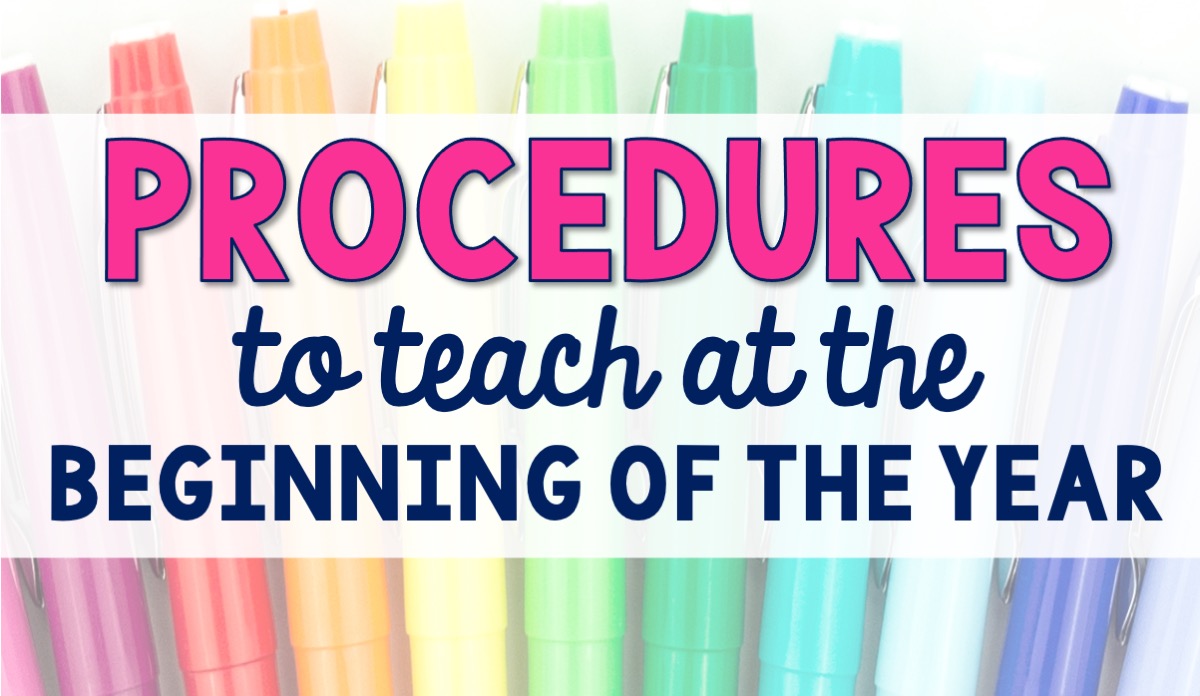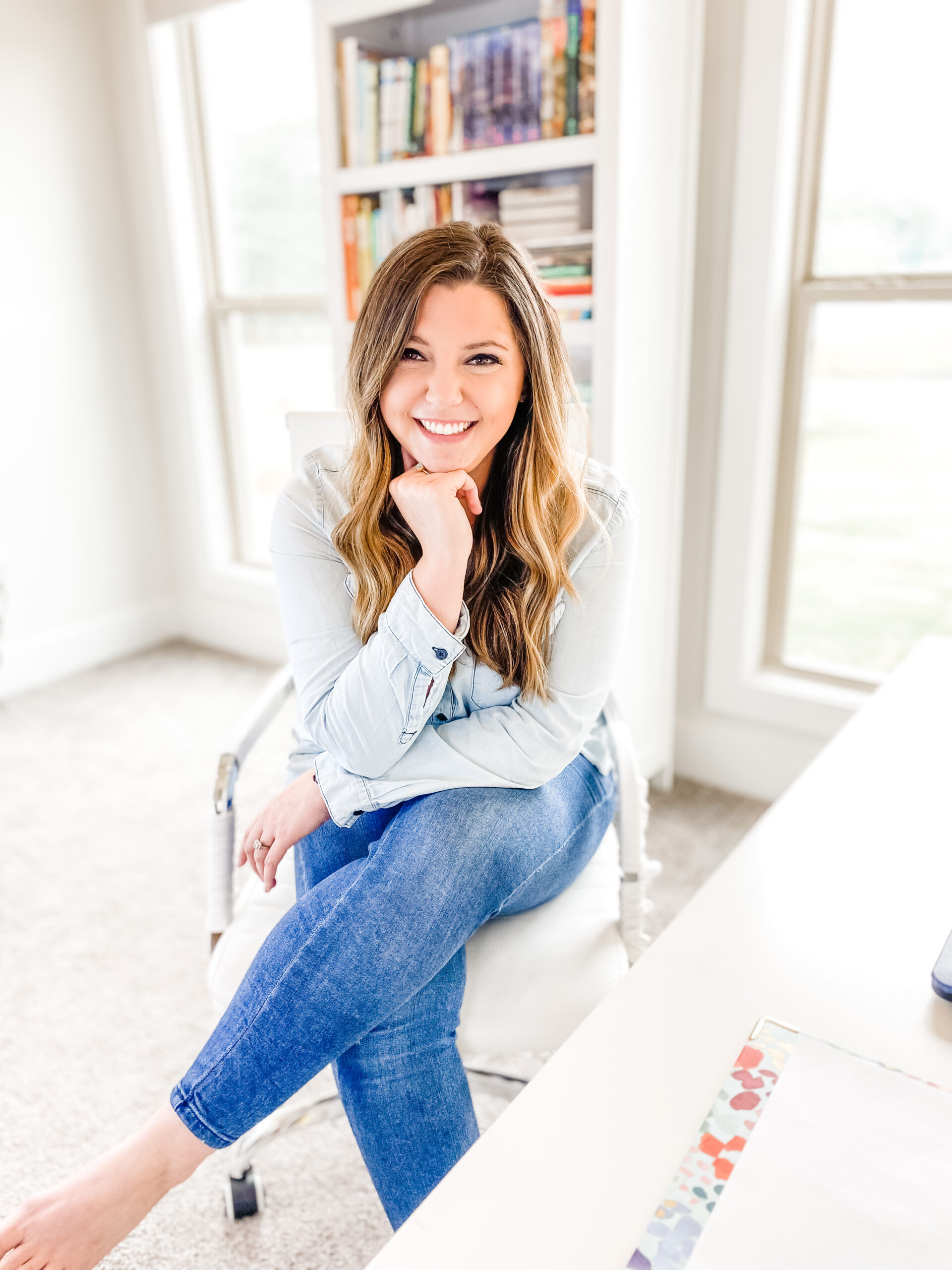When I was a student teacher, I was in awe as I watched my mentor teach procedures and routines in the classroom.
During the first week of school, I remember thinking how odd it was that we weren’t teaching much curriculum- it seemed like all we were doing was teaching procedures and routines in the classroom.
I quickly realized why we spent so much time practicing these over and over.
She could have left the classroom and her first graders would continue like she was still there.
Every child knew what to do AND how to do it, AT ALL TIMES.
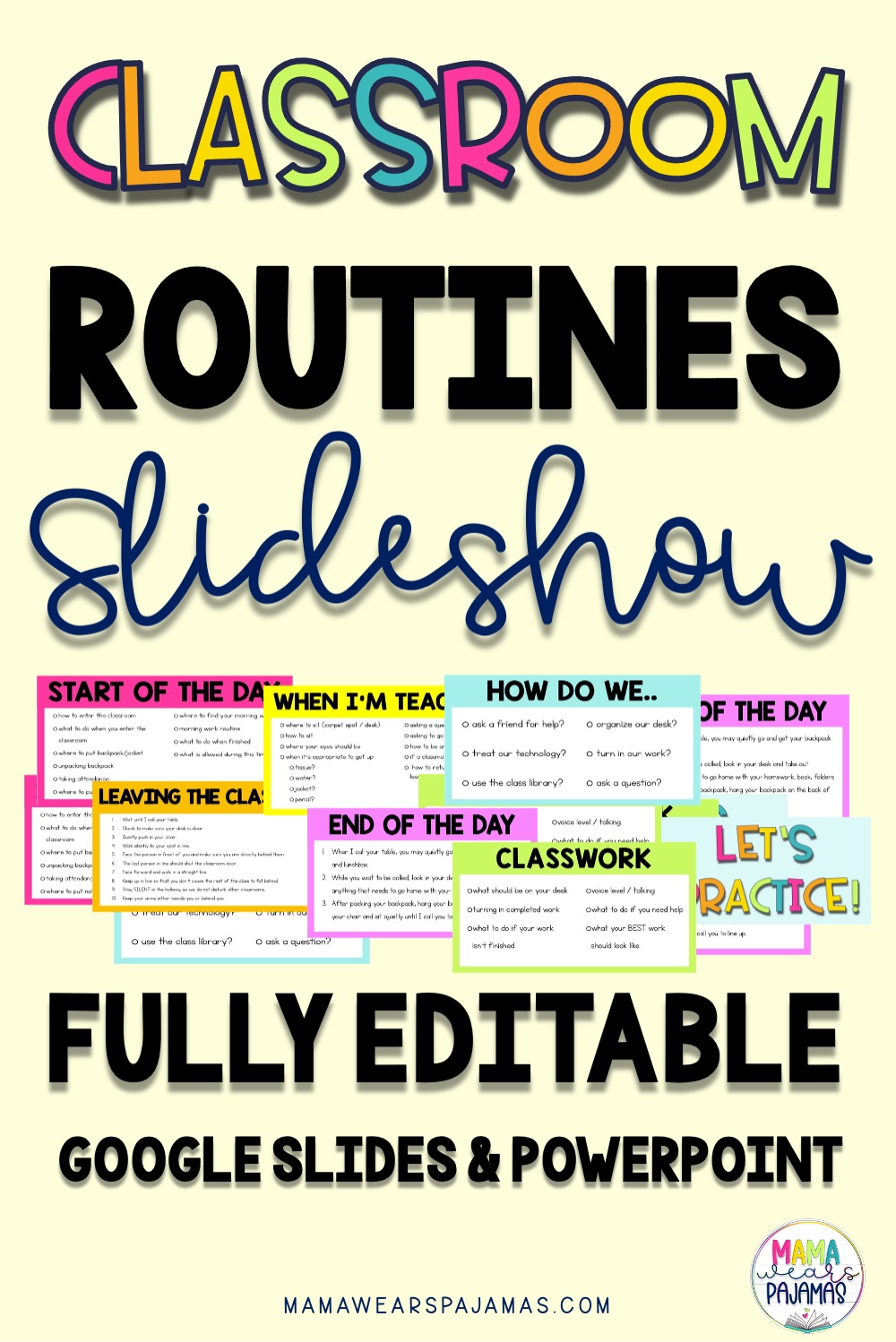
They knew how to turn in an assignment. They knew how to ask to go to the restroom without interrupting a lesson.
At the end of the day, all 20 first graders knew how to reorganize their desk, how to pack their backpack, where to place their backpack when they were finished, and what to do while they waited.
As I observed other classrooms that year and still today, it reminds me of the importance of routines and procedures in the classroom.
I realized that the key to my success as a first year teacher was creating and enforcing my procedures and routines in the classroom.
WHAT ARE PROCEDURES AND ROUTINES FOR CLASSROOM MANAGEMENT?
Classroom procedures and routines for elementary students are the way you teach your students to do things in your classroom.
They tell students HOW to do everything.
- HOW to enter the classroom
- HOW to ask a question
- HOW to turn in completed work
- HOW to walk down the hallway
- HOW to pack up at the end of the day
- and everything in between
THE DIFFERENCE IN RULE, PROCEDURE AND ROUTINE
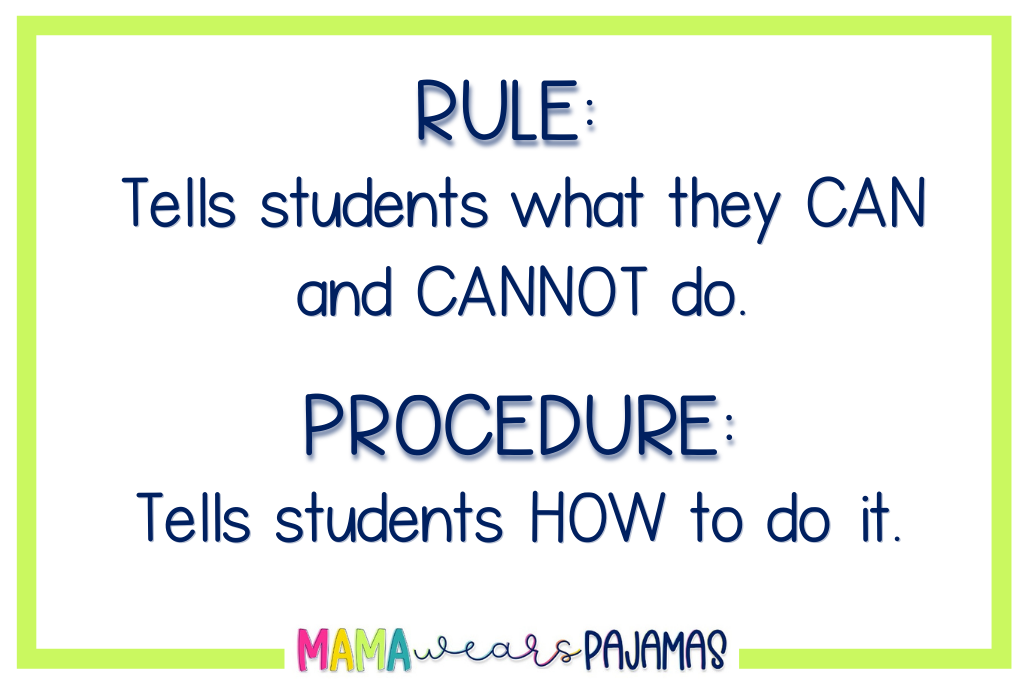
A rule tells your students what they can and cannot do.
A procedure and a routine both tell your students HOW to do things in the classroom.
“Routines allow students to quickly accomplish day-to-day tasks that are required of both the teacher and students. Routines also help to create smoother transitions between activities and therefore allow fewer opportunities for disruptions to occur.” (Burden, 2003; Docking, 2002)
IMPORTANCE OF ROUTINES AND PROCEDURES IN THE CLASSROOM
Routines and Procedures are arguably the most important part of being a successful teacher.
Picture yourself walking into this third grade classroom.
Classroom Scenerio:
You walk into a third grade classroom and the teacher is beginning a math lesson.
3 students are at the pencil sharpener, and several students are talking to each other.
The teacher is shouting over the talking and the pencil sharpener to tell students to sit down and focus.
About half of the students can hear her, so she shouts louder.
2 students are shouting over the pencil sharpener asking the teacher if they can go to the restroom.
I would be a WRECK if admin walked in and my class was that chaotic.
What if this teacher would have taught her students her expectations and routines/procedures?
THE 3 PROCEDURES SHE NEEDS
In my own classroom, these are 3 procedures I would have in place that would have kept ALL of this chaos from happening.
- Pencils- We get 5 sharpened pencils at the beginning of each week. On Friday, students may sharpen their pencils (with their personal pencil sharpener that I purchased for 25 cents each-worth it).
- When I am teaching- Every student is either on their carpet spot, or in their desk being an “active listener.” (active listener= hands in lap, nothing out on your desk, eyes on the teacher, no talking)
- Restroom Breaks- Unless it’s an emergency, you are not to ask to go to the restroom during class. We go before school, mid morning, before lunch, after lunch, and mid afternoon. EVERYONE must go into the restroom and try to go when we are there as a class, so there is no excuse.
Picture the SAME classroom, with those procedures in place:
You walk into a third grade classroom.
Every student is sitting at their desk with their hands in their laps. They are facing the teacher.
The teacher whispers- “if you can hear me, I would like for you to join me on your carpet spot. The timer starts now.”
Every student quietly but quickly pushes in their chair, and calmly walks to their assigned spot on the carpet. They cross their legs, put their hands in their laps, and put their eyes on the teacher.
Once every student is on the carpet correctly, the teacher stops the timer and praises the students.
Doesn’t that sound like a much calmer classroom?
HOW TO DEVELOP CLASSROOM ROUTINES AND PROCEDURES
Here are some basic steps for you to follow if you are beginning to develop your own classroom routines:
Step 1
Write out your schedule for your entire day- minute by minute.
Step 2
Look at your schedule and place a star beside any time that your students are moving from one task to another.
Step 3
Use a sticky note and decide HOW you want students to move from each of those tasks, and what they should do when they move. Should they push in their chair? Should they bring something with them? Should they line up in a certain order?
Write down your procedure for each star on a sticky note.
Step 4
As you are thinking through your schedule and you decide on a procedure or routine in the classroom, write it down.
You’ll want to make yourself a classroom routines and procedures checklist, like this one, to create routines for every single thing in your room. I’ve created a free one for you, with EVERY procedure you could think of!
Download it here, and save yourself some time!
Step 5
The main parts of the day you want to think through to create your routines are the start of the day, leaving the classroom, while I am teaching, independent work, general classroom things, end of the day, and miscellaneous.
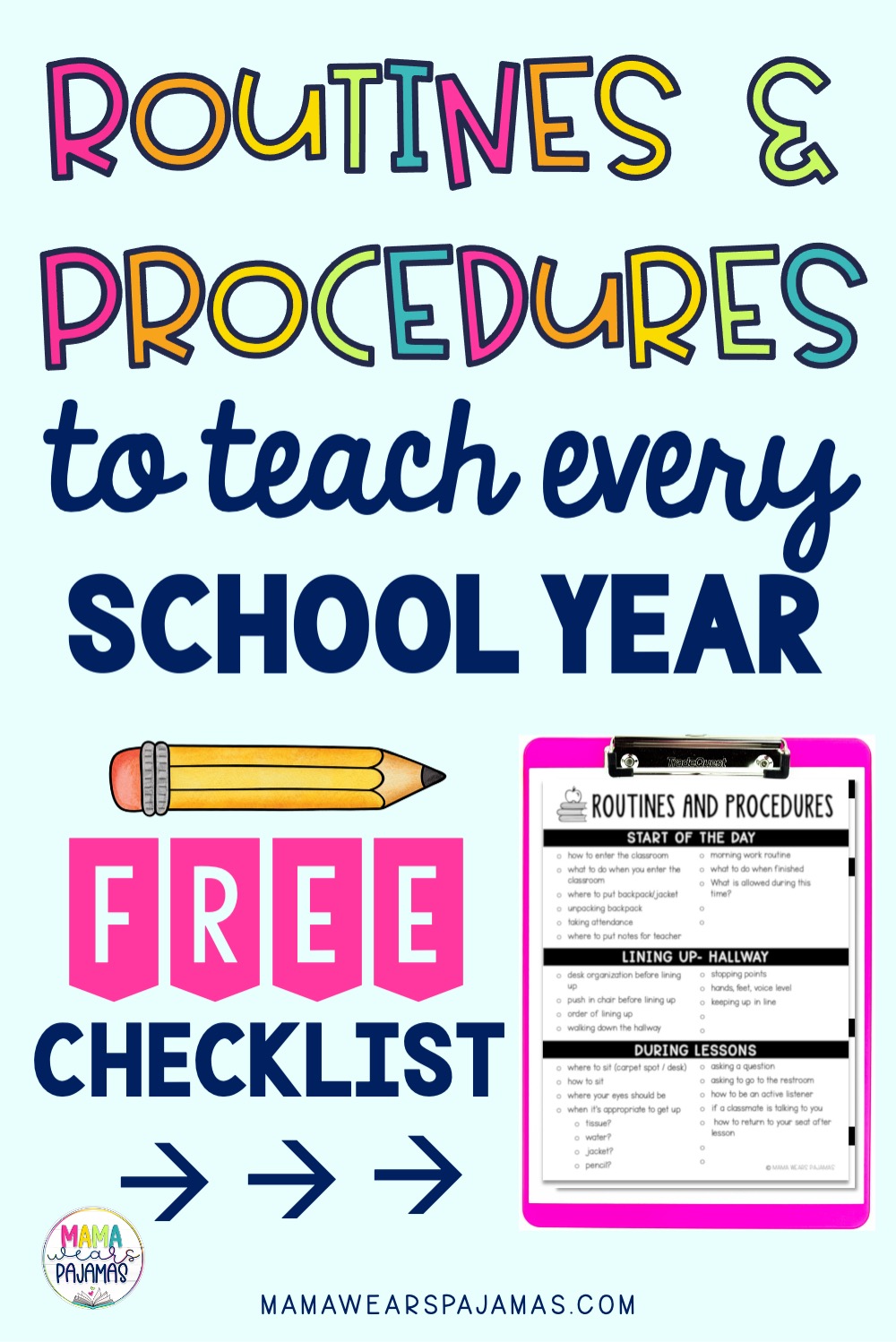
CLASSROOM PROCEDURES AND ROUTINES EXAMPLES
Below are a few examples of routines that I used in my own third grade classroom.
Entering the Classroom at the Start of the Day
- Silently enter the classroom and go straight to your desk.
- Unpack your backpack- take out books, homework folders, and lunchbox
- Turn your homework in to the “Homework Tray”
- Neatly place your backpack and jacket on your hook.
- Place your lunchbox in the lunch cart.
- Turn in any notes or forms into my teacher mailbox beside my desk (no need to tell me).
- Check the board to see your assignment for morning work.
- When you finish your morning work, place it in your morning work folder.
- Complete any unfinished work.
- Read a book silently until I give other instructions.
Leaving the Classroom
- Wait until I call your table.
- Check to make sure your desk is clear.
- Quietly push in your chair.
- Walk silently to your spot in line.
- Face the person in front of you.
- The last person in line will shut the door.
This may look like a lot of steps, but once your students learn them, they will make your class run SO smoothly.
TEACHING ROUTINES AND PROCEDURES IN THE CLASSROOM
It is extremely important to teach the routines and procedures in the classroom at the beginning of the school year.
I always typed out my procedures in a slideshow format and would use the slideshow to teach every procedure during the first few weeks.
It was SO helpful to have slides with my written procedures, because I would leave up the slide that was needed for each part of the day for students to reference.
You can download my Classroom Procedures Slideshow, here, if you think that may be something you would like to do. It’s done for you but also completely editable.
The way that I think about teaching your classroom routines is that the more time and effort you spend creating, teaching and practicing them with your students, the easier your job will be for the rest of the year.
If you focus your time and energy on creating solid routines and procedures and holding your students accountable as you practice, your classroom will run on autopilot.
As you are practicing your routines and procedures, you want to make sure to take notes throughout the day of what worked, what didn’t and what your students still need more practice with.
This will help you know exactly what to focus on the next day.

PRODUCTS TO HELP YOU TEACH RULES AND PROCEDURES
MORE RESOURCES YOU MIGHT ENJOY
- 9 Fun and Effective Ways to Build Classroom Community by Emily at Adventurous Elementary
- 5 Simple but Brilliant Strategies to Build Powerful Student Relationships by Candice at Kandi’s Kinesthetics
- Flexible Seating in Middle School by Sarah at Fab French
- 15 Exciting Ways to Play Would You Rather on the First Day of School by Courtney at Llearning Llama
- 6 Important Considerations for Back to School in First Nation Schools by Hakea at The Remote Teacher
Procedures and routines in the classroom are probably the most important of having a successful school year. It’s worth it to spend time planning and practicing them.
If you are interested in blogging, check out this resource by Kayse Morris! She has been phenomenal in helping my blogging journey!

